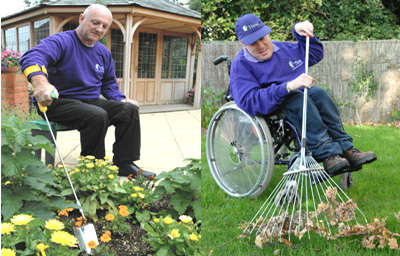The layout of your garden can make a significant difference in how you enjoy garden work. It’s usually best to focus on container growing, but this will depend on your disability. To keep the digging and weeding to a minimum, ensure that any ground level place is low maintenance.
In this read, we are going to take a look at how you can design your garden to make garden work easier. We are also going to include details of the tools and equipment that you may want to use. You’ll come across tips for garden design if you experienced a stroke or suffering from heart disease, can’t bend easily, blind, have one hand, a weak grip, loss of sight, or use a wheelchair.
The Layout
You should avoid huge lawns or lawns with edges that have sharp curves as they tend to take more time to maintain. A semi-wild lawn that features mown paths will save you time and effort. Ideally, keep in mind that lawns tend to be hard to manage, so replace some or the entire lawn with a hard surface.
If you can reach the borders easily, they will be easy to manage. Consider limiting the flower border to 2-feet wide, if you’ll have to access from one side or 4-feet if you can be able to reach from all sides.
Have several seats around the yard so that you can have shady areas to sit and garden during hot days. The seats will also help you save energy.
If you plan to garden on a small scale, then raised beds and containers can be excellent. A raised can be just a few inches in terms of height, but the level depends on whether you can stand or not. The important thing is to have it at a comfortable height.
Ponds are ideally appealing, but keep in mind that they can involve taxing tasks such as clearing weed. Open water is ideally a hazard, depending on your disability It’s best to have a small raised pond as it is easier to maintain and a lot safer. You can also go for a small water feature instead of a pond. The good thing is that you still get to enjoy the visual and sound appeal of running water.
Paths
A path that’s one meter wide is the advisable minimum. If you use a wheelchair, leave adequate space for turning. The average wheelchair has a 1.6 meters turning circle, but some may require as much as 2.4 meters.
If your paths are all even, with a surface that lends you an ideal grip, you’ll feel safer and be able to get tasks done faster.
Varying Levels
Level changes are a hazard in yards, and so, you may want to consider ramps. A general rule of thumb is to have a ramp gradient of 1.15.
Ramps and steps are easier to use if there’s a handrail alongside. The handrail should be sturdy and begin at least a meter before the start of the ramp or the initial step up.
Indoor Area
One of the best ways to enjoy a garden is from a garden room. These spaces can be created to accommodate disabled people and wheelchair users and ramps can easily be added to the spaces. If interested take a look at Quick-garden.co.uk
Plants
When thinking about the garden design and planting scheme, it’s advisable to pick plants that are easy to grow, ideal for your garden’s conditions and do not call for much maintenance. You should check the plant label or even ask for advice when purchasing.
To help reduce weeds, consider ground cover planting.
Ensure that the shrubs and trees are the ideal sizes for the space you have. This will help avoid pruning and cutting them as they grow.
If you want to grow fruit trees, consider espalier and cordon trained varieties as they grow fruits at a level that’s within reach.
Get rid of rampant growers, hazardous plants, those that take up too much space and plants that case too much shade. These problems are not worth it when dealing with some form of disability.
Hedges provide some privacy, but they often need cutting back and can be hard to manage. So, consider alternatives like a fence with climbing plants or a wall. This will make things way much easier.
Tools & Equipment
Get a table for gardening tasks such as potting up and seed sowing. A recess in the table will enable you to reach things easier.
You should always go for safe power sources for any power tools that you might want to use. Also, each electrical tool should have a residual circuit breaker.
Consider having standpipes or water butts installed around the garden in order to save time and effort when you’re watering.
Pick a composite system that’s ideal for you. There are numerous types and bins can be put at varying heights in order to avoid bending.
The paving that you choose should be non-glare and non-slip.
Also, plan how you’re going to move things around the yard. Trolleys, flexible buckets, one-handed use barrows and twin-wheeled light barrows can all prevent strain and save energy.
Even the disabled can enjoy gardening. All you have to ensure is that the garden is safe and convenient for doing your favorite tasks. We hope that this guide has been of great help.
Garden Design Tips for The Disabled



